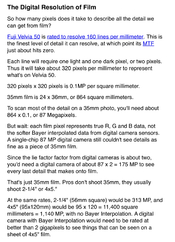DREW WILEY
Member
- Joined
- Jul 14, 2011
- Messages
- 14,572
- Format
- 8x10 Format
Not necessarily. My big compositions are designed to reward a viewer both from a distance and very close up. And in fact, it allows them to discover new things in the details and composition over the years, rewarding repeated viewings. That's just the opposite of advertising photography, which is based on one big "Gotcha" of the attention; and then afterwards, who cares.
Pop Photo was certainly not a scientific journal. Ctein I personally know. Pan X is extinct anyway; and even its results would have all been developer variable. Lens manufacturing and its quality control have changed. Lots of things. A lens which is exceptionally good for a certain variety of digital receptor might not be all that great with film, or visa versa.
Pop Photo was certainly not a scientific journal. Ctein I personally know. Pan X is extinct anyway; and even its results would have all been developer variable. Lens manufacturing and its quality control have changed. Lots of things. A lens which is exceptionally good for a certain variety of digital receptor might not be all that great with film, or visa versa.









